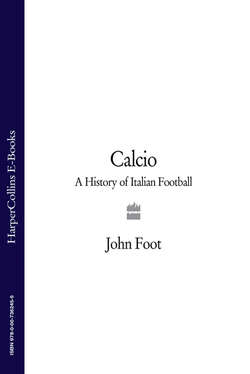Читать книгу Calcio: A History of Italian Football - John Foot - Страница 67
Florence. Purple Pride
ОглавлениеThere is no derby in Florence. Only one team plays there – Fiorentina, a side whose dramatic recent history has overshadowed its glorious past, made up of victories which at times threatened to break the dominance of the big Milan-Turin axis. Fiorentina won the championship in 1956 and reached the European Cup final a year later, losing only to Real Madrid. They then finished second four times in a row, but always by fairly large margins. This was a team constructed by Fulvio Bernardini, one of the most talented and original characters in the history of Italian football. Player, journalist, intellectual, coach, manager, Bernardini remained at the top of the game for two generations and took two provincial clubs – Bologna and Fiorentina – to rare scudetto victories. Bernardini’s record with Fiorentina was exceptional – one championship, three second-place finishes and one fifth place. The second Fiorentina scudetto was the work of ex-Napoli-star-turned-coach Bruno Pesaola, who kept the fiery Brazilian Amarildo under control just long enough to hold off the challenge of Cagliari in 1969.
Fiorentina were never to win another scudetto, but they came very close in the late 1970s and early 1980s with a team built around a stylish, loyal and unlucky midfielder: Giancarlo Antognoni, who suffered a series of horrific injuries. Only some extremely questionable refereeing denied the viola (the purple one) the championship in 1982, and an intense rivalry with Juventus was born. Fiorentina produced a series of superb young players in the 1980s and 1990s, none more so than fan idol Roberto Baggio, whose sale to Juventus in 1990 provoked a riot. Fiorentina replaced Baggio with Gabriel Batistuta, another hero who was loyal enough to play a season in Serie B for the club. With Giovanni Trapattoni on the bench, Fiorentina finished a creditable third in 1998–99. Then, total collapse. Club president and film producer Mario Cecchi Gori died in 1993, and was replaced by his fake-tanned son, Vittorio, who had political ambitions and an empty wallet.
In 2002 Fiorentina went bust, and were sent down to Serie C as punishment after finishing bottom of Serie A. Cecchi Gori was arrested on various charges, including drug use. The team suffered the intense humiliation of losing its name and original symbol – they became Florentia Viola for a year. New owner Diego Della Valle, who had made his money from a fashion company called Tod’s, was forced to buy back the Viola symbol and name at an auction. After rebuilding with a young team, the squad was ‘re-called’ to Serie B in 2003. The sense of injustice felt by Fiorentina fans and players was heightened by the huge debts declared by other big clubs, who were not relegated as a consequence.
The roller-coaster history of Fiorentina in recent years saw the club caught up in the calciopoli scandals of 2006, after qualifying for the Champions League in the previous season, thanks largely to the goals of Luca Toni. Nineteen points were docked from the team in the 2006–7 season (reduced to 15 on appeal) and they also lost their European place. Nonetheless, the team played admirably to pull themselves out of trouble and qualify for the UEFA cup.
